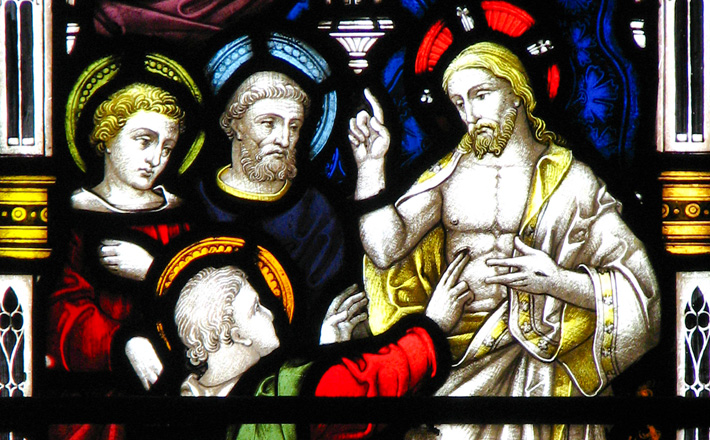Commentary on Acts 2:14a, 22-32
Today’s passage is part of Peter’s sermon following the original, powerful experience of the Holy Spirit at Pentecost.
The experience of the Spirit began with a sound like a strong wind and tongues of fire extending to all members of the early Christian community as they gathered in the upper room (2:1-3).
The Spirit then enabled the gathered to speak “in other tongues” (2:4), and when the many Jews from disparate nations who were in Jerusalem became aware of the spectacle, the Spirit enabled them all to hear the Christians in their own languages (2:5-13). Peter then stood up to speak to the crowd, as told in the opening part of today’s passage (2:14a).
The sermon has two main parts to it, each with its own main point:
The first part (2:15-21) interprets these happenings as the “last days” fulfillment of the prophet Joel’s promise of God’s Spirit being poured out on all people.
The second (2:22-36), from which our passage comes, focuses on Jesus, especially his death and resurrection, the main point being that these were part of God’s plan as revealed in prophetic Psalms.
The end of this second section then relates the story of Jesus back to the Pentecost events, with Peter demonstrating that it is in fact the risen and exalted Jesus who has poured out the gift of the Spirit (verse 33). The Pentecost events then in turn serve as a call to recognize Jesus’ status as “both Lord and Christ” (verse 36). Peter’s speech thus serves to link the story of Jesus with the giving of the Spirit and to interpret both as fulfilling Old Testament prophecies.
Besides the introductory verse 14a, our passage has three parts to it:
Verses 22-24 quickly summarize the life, death, and resurrection of Jesus.
Verses 25-31 interpret Jesus’ resurrection as the fulfillment of Psalm 16:8-11.
Verse 32 restates Jesus’ resurrection as God’s act and asserts the apostles’ status as witnesses of it.
In summarizing the story of Jesus (verses 22-24), Peter points out the unfortunate contrast between the divine attestation of Jesus by his miracles, on the one hand, and his treatment by the audience on the other (“[whom] you crucified and killed,” verse 23).
There has been much discussion in recent years over the question of who killed Jesus, an understandable concern given Christians’ unfortunate tendency throughout history to label Jews as “Christ-killers.” Here Peter clearly does implicate his audience in Jesus’ death, but it is important to note that he is addressing a group of Jerusalem Jews located at a specific point in time. Peter’s statement would be nonsensical if taken to refer to Jews from any other period, or even to Jews located anywhere besides Jerusalem from his own period.
And, of course, Peter and the other members of the early Christian community in Jerusalem were themselves Jews. Modern historians tend to emphasize the Roman responsibility for Jesus’ death, which Peter himself alludes to in his reference to “those outside the law” being involved (v. 23).
The point of the blame for Jesus’ death is not belabored, in any case, as Peter’s ultimate point is the accomplishment of God’s plan, including Jesus’ death, but focusing on his resurrection. Resurrection is not a common topic in the Old Testament, but Peter finds a verse from Psalm 16 that suggests it, even if only obliquely: “For you will not abandon my soul to Hades, or let your Holy One experience corruption” (verse 27; Psalm 16:10).
As verses 29-31 explain, this statement could not apply to the psalmist himself, i.e. to David, as it is certain that David died and that his body experienced the normal subsequent decay (“corruption”). It is important to note here that the line from the psalm is interpreted in an ultimate sense — while one might interpret the line more mundanely as referring to a momentary experience of salvation from death, Peter takes it much more strongly, no doubt because the experience of Christ’s resurrection had suggested such an importance!
It is often the case in the New Testament that the powerful experiences of the resurrection and the Spirit enable the authors to see things in the Old Testament scriptures that had not been seen before. Critics sometimes find such interpretations forced or unconvincing, but I suggest that the interpretation of scripture through the lens of our experiences of God’s work through Christ and the Spirit remains an important interpretive principle.
Two points about this passage may be especially fruitful for preaching. First, the passage sets Jesus’ death and resurrection in the context of God’s larger plan and activity in the people and story of Israel. What happened to Jesus was not a new story but the continuation — and climax — of an old story. Jesus’ death and resurrection came as surprises to his first followers and to Israel, but only in the way that good stories usually have surprising climaxes.
And similarly, the surprising climax makes us reevaluate all that came before in the story. The story of Jesus is the center of the story of human history. Second, we must remember the whole reason Peter brings up the story of Jesus here: to explain the experience of the Spirit at Pentecost. The Spirit’s work must be connected to the story of Jesus.
This invites us to reflect on the work of the Spirit in our own lives: How can we understand God’s work in, among, and through us as part of the story of Jesus, particularly as part of the story of his death and resurrection? If our own stories cannot be meaningfully connected to that of Jesus, we have somewhere gone astray. The symbols of the cross and the empty tomb ought to characterize all that we do as Christians, whether individually or corporately. Or perhaps better put, these symbols ought to be the lenses through which we view all that God performs in and through our lives.


April 27, 2014